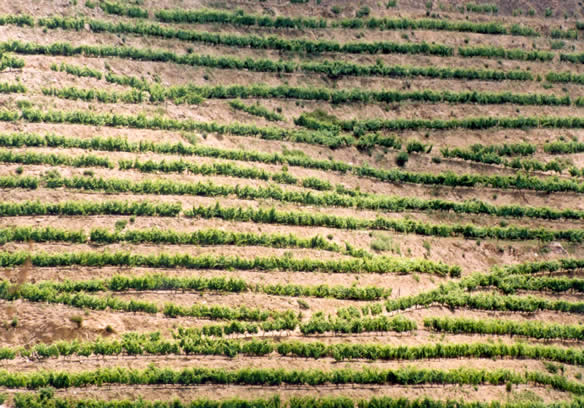|
The
wineanorak's guide to
PORTUGAL'S WINE
REGIONS

Part 2: Alentejo, Ribatejo and Estremadura
Alentejo
The Alentejo has led the way in Portugalís wine revolution.
Itís a region that has enjoyed tremendous success over the last
decade, producing red wines in two distinctive styles. On the one
hand, there is the traditional Alentejo style. This is typified by Josť
Maria da Fonsecaís Josť de Sousa, part of which is fermented in
clay pots, and which displays leathery, herby, sweet-spice complexity.
Another traditional style producer is Cartuxa (from Evora), best known
for the brilliant but unusual cult wine Pera Manca. On the other hand,
there is the modern, fruit-forward, almost new-world style that has
been such a huge commercial success and which has propelled this
region forward so fast.
The Alentejo is huge, with its flat plains covering almost
a third of the country. Much of this area is given over to cereal
production. Itís also hot, and irrigation is common. In contrast to
the northern regions, with their fragmented smallholdings, production
is dominated by large, professional outfits.
Two of Portugalís most high-profile winemakers have been
key in developing the reputation of Alentejo wines. First, Jo„o
Portugal Ramos, celebrated consultant winemaker and now with his own
estate at Estremoz. He makes impressive yet still-affordable red wines
that successfully combine ripe, concentrated fruit flavours with
carefully managed oak. The second is David Baverstock at Espor„o, who
also consults for a number of estates in the Douro. Ramos and
Baverstock have concentrated on local grape varieties, but in recent
vintages both have been making a Syrah, the only foreign grape to so
far to have made much of an inroad into the region. The great success
of the Alentejo has been in making thoroughly modern, concentrated
wines that still retain a distinctly Portuguese character. Demand
exceeds supply here, and large companies such as Caves AlianÁa and
Sogrape have invested in the region. Other names to watch out for
include Cortes de Cima and Mouch„o.
Ribatejo
For a long time the provider of bulk wine, the Ribatejo is now
emerging as an exciting source of modern-styled commercially astute
red wines. The fertile alluvial soils on the banks of the river Tagus
produce soft-textured, ripe, drinkable reds in the sorts of quantities
and at the price points that excite supermarket buyers. Further up, on
the stonier soils more serious wines can be made. Unlike most other
Portuguese regions, foreign varieties such as Cabernet Sauvignon and
Merlot are quite common here, and seem to do well. Jo„o Ramos has a
thriving venture here under the name of Falua, which makes half a
million cases a year and is soon to be relaunched under the label of
Jo„o Portugal Ramos Ribatejo. Ramosí ex-deputy, Rui Reguinga, is
another high-profile winemaker who consults for a number of producers
in the region, including Quinta do Lagoalva, a large estate owned by
the Campilho family. The future looks relatively bright for the
Ribatejo.
Estremadura
A long, thin region running up the Atlantic coast from Lisbon,
Estremadura has struggled in the past as a producer of bulk wine from
tired cooperatives. While the region is still quite a mixed bag, there
are some impressive wines emerging at both the quality and volume ends
of the market. As in the Ribatejo, itís not uncommon to find
international grape varieties planted here. The dominant figure in
Estremadura is winemaker Josť Neiva, of DFJ Vinhos. Dubbed the Jo„o
Ramos of central Portugal, his company makes a broad range of overtly
commercial red wines characterised by their ripe, accessible fruit,
lush textures and good concentration, all at very affordable prices.
Neiva is quite open about the interventionist winemaking techniques
that he uses to wring every drop of flavour from his grapes. Some
appealing fruity whites are also made here.
Back to top
|

